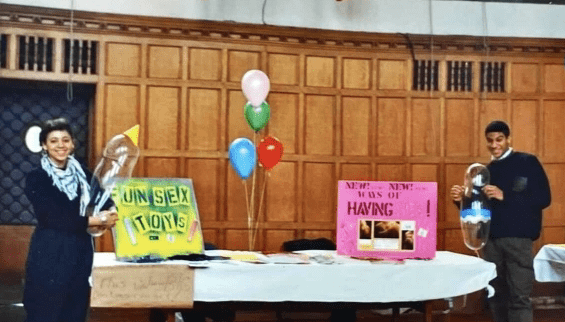by Ally Knapp, Class of 2024, Feminist, Gender, and Sexuality Studies

information fair during AIDS Awareness Week, Willard Straight Hall, 1989. Ari Van Tienhoven, Cornell Biology and Society 451 “AIDS and Society” scrapbooks, 1989 1992. Scrapbooks from”AIDS and Society” class, Box 1. Human Sexuality Collection, Rare and Manuscript Collections. Cornell University Libraries.
Organized by professor emeritus Ari Van Tienhoven, Cornell’s course “AIDS and Society/Biology and Society 451” was taught for the first time in 1989. The class was designed to discuss the AIDS epidemic and the myriad of problems and controversies that surrounded the issue as well as the consequences of not fully understanding the disease. He brought guest lecturers who were experts in different fields related to AIDS/HIV, and instead of requiring his students to write papers or take exams, Van Tienhoven asked them to organize a public event on AIDS. He wanted the event to be both informative as well as an expression of how the students felt about AIDS and the issues that they had learned about in class. So, the students planned. In 1989, they chose to create the first AIDS Awareness Week at Cornell, an effort to bring attention to AIDS, educate the campus, and counteract any lack of action on the part of the Cornell community.

first Cornell AIDS Awareness Week, Willard Straight Hall, 1989. AIDS and Society” scrapbooks.
The week consisted of events such as Students for AIDS Facts, Education, and Responsibility (S.A.F.E.R.) workshops, information fairs, a class performance of skits about AIDS ranging from comic relief pieces such as the “First Annual Cornell Condom Fashion Show” to demonstrations of pain and ostracism such as “Living with AIDS.” It concluded with a candlelight vigil honoring World AIDS Day in the Commons. Throughout the week, the NAMES project quilt was hung in the Johnson Museum, an international memorial consisting of patches sent in by families of victims of AIDS, linking them to the perpetually growing quilt (which in full form, spanned the distance of twelve football fields). The class not only educated the students enrolled but also provided a conduit for the rest of the Cornell community to learn more about AIDS, and that is exactly what AIDS Awareness Week did.

In the end, it was the students and faculty who were committed to spreading awareness about AIDS who made courses and events like these possible. In fact, Professor Van Tienhoven told the Cornell Daily Sun that funds for the class were inadequate, “So the course is now financed by the wife of a retired professor,” he said in reference to his own wife. The 23 students enrolled in the class at the time even raised over $700 to ensure that the course could continue being offered, although Professor Van Tienhoven refused the money and donated it to AIDS education elsewhere. Efforts such as the “AIDS and Society/Biology and Society 451” course and the AIDS Awareness Week that the semester culminated in are the reasons that AIDS began receiving broad community attention. These were efforts by students and faculty for the entire Cornell community, made possible by a group of students and faculty who cared about bringing attention to this devastating epidemic.
Sources
“AIDS Awareness.” The Cornell Daily Sun. November 28, 1989.
Ari Van Tienhoven, Cornell Biology and Society 451 “AIDS and Society” scrapbooks, 1989-1992. Scrapbooks from “AIDS and Society” class, Box 1. Human Sexuality Collection, Rare and Manuscript Collections. Cornell University Libraries.
Baylin, Noah. “Students’ Awareness Week Examines AIDS Epidemic.” The Cornell Daily Sun (Ithaca, NY), November 29, 1989.
